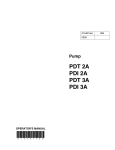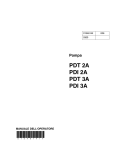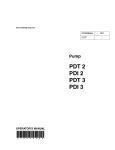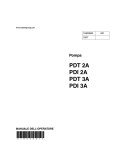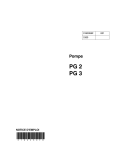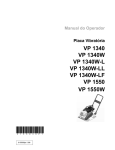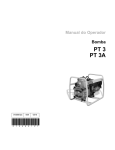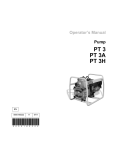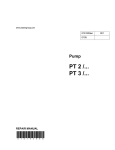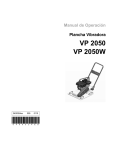Download Wacker Neuson PDI 3 Repair manual
Transcript
www.wackergroup.com 0163153en 0606 Pump PDT 2 PDI 2 PDT 3 PDI 3 REPAIR MANUAL 0 1 6 3 1 5 3 E N 001 PD Repair Foreword This manual covers machines with Item Number: 0007610, 0007614, 0007624, 0007625, 0007628, 0007629, 0009407, 0009489, 0009491, 0009492, 0009494, 0009495 Operating / Parts Information You must be familiar with the operation of this machine before you attempt to troubleshoot or repair it. Basic operating and maintenance procedures are described in the Operator’s Manual supplied with the machine. Keep a copy of the Operator’s Manual with the machine at all times. Use the separate Parts Book supplied with the machine to order replacement parts. If you are missing either of the documents, please contact Wacker Corporation to order a replacement. Damage caused by misuse or neglect of the unit should be brought to the attention of the operator to prevent similar occurrences from happening in the future. This manual provides information and procedures to safely repair and maintain the above Wacker model(s). For your own safety and protection from injury, carefully read, understand, and observe all instructions described in this manual. THE INFORMATION CONTAINED IN THIS MANUAL IS BASED ON MACHINES MANUFACTURED UP TO THE TIME OF PUBLICATION. WACKER CORPORATION RESERVES THE RIGHT TO CHANGE ANY PORTION OF THIS INFORMATION WITHOUT NOTICE. wc_tx000591gb.fm i Foreword WARNING PD Repair CALIFORNIA Proposition 65 Warning: Engine exhaust, some of its constituents, and certain vehicle components, contain or emit chemicals known to the State of California to cause cancer and birth defects or other reproductive harm. Laws Pertaining to Spark Arresters Notice: State Health Safety Codes and Public Resources Codes specify that in certain locations spark arresters be used on internal combustion engines that use hydrocarbon fuels. A spark arrester is a device designed to prevent accidental discharge of sparks or flames from the engine exhaust. Spark arresters are qualified and rated by the United States Forest Service for this purpose. In order to comply with local laws regarding spark arresters, consult the engine distributor or the local Health and Safety Administrator. All rights, especially copying and distribution rights, are reserved. Copyright 2006 by Wacker Corporation No part of this publication may be reproduced in any form or by any means, electronic or mechanical, including photocopying, without express written permission from Wacker Corporation. Any type of reproduction or distribution not authorized by Wacker Corporation represents an infringement of valid copyrights, and violators will be prosecuted. We expressly reserve the right to make technical modifications, even without due notice, which aim at improving our machines or their safety standards. wc_tx000591gb.fm ii PD 2/3 1. Safety Information 1.1 1.2 1.3 1.4 1.5 2. Operating Safety .................................................................................. 4 Operator Safety while using Internal Combustion Engines .................. 5 Service Safety ...................................................................................... 5 Label Locations ................................................................................... 6 Safety Labels ........................................................................................ 7 10 Engine—Machines with Honda Engines ............................................ 10 Pump—Machines with Honda Engines .............................................. 11 Sound Measurements—Machines with Honda Engines .................... 11 Dimensions—Machines with Honda Engines ..................................... 12 Engine—Machines with Wacker Engines ........................................... 13 Pump—Machines with Wacker Engines ............................................ 14 Sound Measurements—Machines with Wacker Engines ................... 14 Operation 3.1 3.2 3.3 3.4 3.5 3.6 3.7 3.8 3.9 3.10 3.11 4. 3 Technical Data 2.1 2.2 2.3 2.4 2.5 2.6 2.7 3. Table of Contents 15 Application .......................................................................................... 15 Recommended Fuel ........................................................................... 15 Priming Pump ..................................................................................... 16 Before Starting ................................................................................... 16 To Start—Machines with Honda Engines ........................................... 17 To Stop—Machines with Honda Engines ........................................... 17 To Start—Machines with Wacker Engines ......................................... 18 To Stop—Machines with Wacker Engines ......................................... 18 Operation ............................................................................................ 19 Accessories ........................................................................................ 19 Hoses and Clamps ............................................................................. 20 Maintenance 4.1 4.2 4.3 4.4 22 Periodic Maintenance Schedule ......................................................... 22 Changing Engine Oil—Machines with Honda Engines ...................... 23 Changing Engine Oil—Machines with Wacker Engines ..................... 24 Cleaning Fuel Strainer—Machines with Wacker Engines .................. 24 wc_br0163153001enTOC.fm 1 Table of Contents 4.5 4.6 4.7 4.8 4.9 4.10 4.11 4.12 4.13 4.14 5. PD 2/3 Cleaning Sediment Cup—Machines with Honda Engines ..................25 Carburetor Adjustment—Machines with Honda Engines ....................25 Servicing Air Cleaner—Machines with Honda Engines .......................26 Servicing Air Cleaner—Machines with Wacker Engines .....................27 Spark Plug ...........................................................................................28 Gear Case ...........................................................................................29 Lubricating Connecting Rod Bearing ...................................................30 Cleaning Pump ....................................................................................30 Storage ................................................................................................31 Troubleshooting ...................................................................................32 Disassembly/Assembly Procedures 5.1 5.2 5.3 5.4 5.5 5.6 5.7 5.8 5.9 5.10 5.11 5.12 33 Tools ....................................................................................................33 Ordering Parts .....................................................................................33 Reference Numbers ( ) ........................................................................33 Replacing the Flapper Valve ...............................................................34 Replacing the Diaphragm ....................................................................36 Replacing the Connecting Rod and Bearing .......................................38 Replacing the Engine ..........................................................................40 Gearbox Exploded View ......................................................................42 Gearbox Components .........................................................................43 Gearbox Disassembly .........................................................................44 Gearbox Reassembly ..........................................................................46 Testing .................................................................................................48 wc_br0163153001enTOC.fm 2 PD 2/3 1. Safety Information Safety Information This manual contains DANGER, WARNING, CAUTION, and NOTE callouts which must be followed to reduce the possibility of personal injury, damage to the equipment, or improper service. This is the safety alert symbol. It is used to alert you to potential personal injury hazards. Obey all safety messages that follow this symbol to avoid possible injury or death. DANGER indicates a hazardous situation which, if not avoided, will result in death or serious injury. DANGER WARNING indicates a hazardous situation which, if not avoided, could result in death or serious injury. WARNING CAUTION indicates a hazardous situation which, if not avoided, could result in minor or moderate injury. CAUTION CAUTION: Used without the safety alert symbol, CAUTION indicates a potentially hazardous situation which, if not avoided, may result in property damage. Note: Contains additional information important to a procedure. wc_si000176gb.fm 3 Safety Information 1.1 Operating Safety DANGER wc_si000176gb.fm PD 2/3 Internal combustion engines present special hazards during operation and fueling. Read and follow the warning instructions in the engine owner’s manual and the safety guidelines below. Failure to follow the warnings and safety guidelines could result in severe injury or death. 1.1.1 NEVER allow anyone to operate this equipment without proper training. People operating this equipment must be familiar with the risks and hazards associated with it. 1.1.2 NEVER touch the engine or muffler while the engine is on or immediately after it has been turned off. These areas get hot and may cause burns. 1.1.3 NEVER use accessories or attachments that are not recommended by Wacker. Damage to equipment and injury to the user may result. 1.1.4 NEVER pump volatile, flammable or low flash point fluids. These fluids could ignite or explode. 1.1.5 NEVER pump corrosive chemicals or water containing toxic substances. These fluids could create serious health and environmental hazards. Contact local authorities for assistance. 1.1.6 ALWAYS read, understand, and follow procedures in the Operator’s Manual before attempting to operate the equipment. 1.1.7 ALWAYS be sure operator is familiar with proper safety precautions and operation techniques before using machine. 1.1.8 ALWAYS be sure the machine is on a firm, level surface and will not tip, roll, slide, or fall while operating. 1.1.9 ALWAYS close fuel valve on engines equipped with one when machine is not being operated. 1.1.10 ALWAYS store the equipment properly when it is not being used. Equipment should be stored in a clean, dry location out of the reach of children. 4 PD 2/3 1.2 Safety Information Operator Safety while using Internal Combustion Engines Poorly maintained equipment can become a safety hazard! In order for the equipment to operate safely and properly over a long period of time, periodic maintenance and occasional repairs are necessary. WARNING 1.3 1.2.1 DO NOT smoke while operating the machine. 1.2.2 DO NOT smoke when refueling the engine. 1.2.3 DO NOT refuel a hot or running engine. 1.2.4 DO NOT refuel the engine near an open flame. 1.2.5 DO NOT spill fuel when refueling the engine. 1.2.6 DO NOT run the engine near open flames. 1.2.7 ALWAYS refill the fuel tank in a well-ventilated area. 1.2.8 ALWAYS replace the fuel tank cap after refueling. Service Safety Poorly maintained equipment can become a safety hazard! In order for the equipment to operate safely and properly over a long period of time, periodic maintenance and occasional repairs are necessary. WARNING wc_si000176gb.fm 1.3.1 DO NOT attempt to clean or service the machine while it is running. Rotating parts can cause severe injury. 1.3.2 DO NOT crank a flooded engine with the spark plug removed on gasoline-powered engines. Fuel trapped in the cylinder will squirt out the spark plug opening. 1.3.3 DO NOT test for spark on gasoline-powered engines if the engine is flooded or the smell of gasoline is present. A stray spark could ignite the fumes. 1.3.4 DO NOT use gasoline or other types of fuels or flammable solvents to clean parts, especially in enclosed areas. Fumes from fuels and solvents can become explosive. 1.3.5 ALWAYS operate the machine with all safety devices and guards in place and in working order. 1.3.6 ALWAYS keep the area around the muffler free of debris such as leaves, paper, cartons, etc. A hot muffler could ignite the debris and start a fire. 1.3.7 ALWAYS replace worn or damaged components with spare parts designed and recommended by Wacker Corporation. 1.3.8 ALWAYS disconnect the spark plug on machines equipped with gasoline engines, before servicing, to avoid accidental start-up. 5 Safety Information Label Locations CAUTION VORSICHT GREASE CONNECTING ROD BEARING MONTHLY PLEUELLAGER JEDEN MONAT SCHMIEREN PRECAUCION PRECAUTION ENGRASE RODAMIENTO DE LA BIELA MENSUALMENTE GRAISSER ROULEMENT DE LA BIELLE TOUS LES MOIS 30744 1.4 PD 2/3 WARNING DO NOT OPERATE WITHOUT SAFETY GUARDS. READ AND UNDERSTAND INSTRUCTION BOOK. WARNUNG NICHT OHNE SCHUTZVORRICHTUNG BETREIBEN. BEDIENUNGSANWEISUNG GENAU DURCHLESEN. ADVERTENCIA AVERTISSEMENT NE PAS OPERER SANS DEFLECTEUR PROTECTIF. LIRE ET COMPRENDRE LES INSTRUCTIONS DE SERVICE. wc_si000176gb.fm 6 117431 NO OPERE SIN LOS DISPOSITIVOS DE SEGURIDAD. LEA Y ENTIENDA PRIMERO LAS INSTRUCCIONES. PD 2/3 Safety Information 1.5 Safety Labels Wacker machines use international pictorial labels where needed. These labels are described below: Label Meaning DANGER! Engines emit carbon monoxide; operate only in well-ventilated area. Read the Operator’s Manual. No sparks, flames, or burning objects near the machine. Shut off the engine before refueling. WARNING! Hot surface! CAUTION! Read and understand the supplied Operator’s Manuals before operating this machine. Failure to do so increases the risk of injury to yourself or others. WARNING! Pinch point! Do not operate without safety guards. Read and understand the operator’s manual. WARNING DO NOT OPERATE WITHOUT SAFETY GUARDS. READ AND UNDERSTAND INSTRUCTION BOOK. WARNUNG NICHT OHNE SCHUTZVORRICHTUNG BETREIBEN. BEDIENUNGSANWEISUNG GENAU DURCHLESEN. ADVERTENCIA AVERTISSEMENT NE PAS OPERER SANS DEFLECTEUR PROTECTIF. LIRE ET COMPRENDRE LES INSTRUCTIONS DE SERVICE. VORSICHT GREASE CONNECTING ROD BEARING MONTHLY PLEUELLAGER JEDEN MONAT SCHMIEREN PRECAUCION PRECAUTION ENGRASE RODAMIENTO DE LA BIELA MENSUALMENTE GRAISSER ROULEMENT DE LA BIELLE TOUS LES MOIS wc_si000176gb.fm CAUTION! Grease connecting rod bearing monthly. 30744 CAUTION 117431 NO OPERE SIN LOS DISPOSITIVOS DE SEGURIDAD. LEA Y ENTIENDA PRIMERO LAS INSTRUCCIONES. 7 Safety Information Label PD 2/3 Meaning CAUTION! Lifting point Guaranteed sound power level in dB(A) wc_si000176gb.fm 8 PD 2/3 wc_si000176gb.fm Safety Information 9 Technical Data 2. PD Technical Data 2.1 Engine—Machines with Honda Engines Item Number: PDT/PDI 2A 0007610, 0007611 0007624, 0007625 PDT/PDI 3A 0007614, 0007615, 0007616, 0007628, 0007629, 0009407 Engine Engine Make Honda Engine Model GX 120 K1 QX 3.0 (4.0) Rated Power kW (Hp) Spark Plug type Electrode Gap mm (in.) Engine speed rpm 2700 ± 100 Air Cleaner type Dual element Engine Lubrication oil grade SAE10W30 - service class SF, SE, SD, or SC Engine Oil Capacity ml (oz.) 600 (20) Fuel type Fuel Tank Capacity l (qts.) wc_td000178gb.fm (NGK) BPR 6ES, BOSCH WR 7DC 0.7 – 0.8 (0.028 – 0.031) Regular unleaded gasoline 2.5 (2.6) 10 PD Technical Data 2.2 Pump—Machines with Honda Engines Item Number: PDT/PDI 2A 0007610, 0007611 0007624, 0007625 PDT/PDI 3A 0007614, 0007615, 0007616, 0007628, 0007629, 0009407 Pump Weight kg (lbs.) 52 (114) 63 (138) *Max. Suction Lift m (ft.) 7.5 (25) Max. Discharge Head m (ft.) 7.5 (25) Max. Total Head m (ft.) 15 (50) Max. Discharge Pressure kg/cm2 (psi) 0.76 (10.8) Max. Discharge Flow m3h (gpm) Gear Case Lubrication 11 (50) 20 (88) oil grade ml (oz.) SAE 80W-90 532 (18) SAE 80W-90 532 (18) Suction / Discharge Dia. mm (in.) 50 (2) 75 (3) Maximum Solid Size mm (in.) 30 (1.25) 45 (1.75) * Based on pump operating at sea level. Maximum suction lift will be less at higher altitudes. 2.3 Sound Measurements—Machines with Honda Engines The required sound specification, Paragraph 1.7.4.f of 89/392/EEC Machinery Directive, is: • the guaranteed sound power level (LWA) = 96 dB(A). • the sound pressure level at operator’s location (LpA) = 82 dB(A). These sound values were determined according to ISO 3744 for the sound power level (LWA) and ISO 6081 for the sound pressure level (LpA) at the operator’s location. wc_td000178gb.fm 11 Technical Data 2.4 PD Dimensions—Machines with Honda Engines mm (in.) P D T 2 A /3 A P D T 2 A - 6 3 5 (2 5 ) P D T 3 A - 7 5 0 (2 9 .5 ) P D T 2 A - 1 0 1 5 (4 0 ) P D T 3 A - 1 0 1 5 (4 0 ) P D T 2 A - 5 7 2 (2 2 .5 ) P D T 3 A - 6 1 0 (2 4 ) P D I 2 A /3 A P D I 2 A - 4 4 5 (1 7 .5 ) P D I 3 A - 4 4 5 (1 7 .5 ) P D I 2 A - 1 0 1 5 (4 0 ) P D I 3 A - 1 0 1 5 (4 0 ) P D I 2 A - 5 7 2 (2 2 .5 ) P D I 3 A - 6 1 0 (2 4 ) w c _ g r0 0 1 0 6 2 wc_td000178gb.fm 12 PD Technical Data 2.5 Engine—Machines with Wacker Engines Item Number: PDI/PDT 2 0009489, 0009494 PDI/PDT 3 0009491, 0009492, 0009495 Engine Engine Make Wacker Engine Model WM 130 Displacement cm3 (in3) Engine Speed rpm Max. Operating Power Spark Plug Electrode Gap Air Cleaner 126 (7.7) 2800 3.2 (4.3) kW (Hp) NGK BR6HS (Champion RL86C) type 0.6–0.7 (0.024–0.028) mm (in.) Dual element type Engine Lubrication oil grade SAE10W30 - SE or higher Engine Oil Capacity ml (oz.) 600 (20) Fuel Fuel Tank Capacity Fuel Consumption Running Time wc_td000178gb.fm Regular unleaded gasoline type l (qts.) 2.7 (2.9) l (qts.)/hr. 1.1 (1.2) 2.5 hr. 13 Technical Data 2.6 PD Pump—Machines with Wacker Engines Item Number: PDI/PDT 2 0009489, 0009494 PDI/PDT 3 0009491, 0009492, 0009495 Pump Dimensions (L x W x H) mm (in.) 1010 x 630 x 570 (40 x 25 x 22.5) 1010 x 745 x 605 (40 x 29.3 x 24) 52 (114) 61 (133) Operating Weight kg (lbs.) *Max. Suction Lift m (ft.) 7.5 (25) Max. Discharge Head m (ft.) 7.5 (25) Max. Flow Rate l/m (gpm) Gear Case Lubrication oil grade ml (oz.) 189 (50) 333 (88) SAE 80W-90 532 (18) Suction / Discharge Dia. mm (in.) 50 (2) 75 (3) Maximum Solid Size mm (in.) 32 (1.25) 45 (1.75) * Based on pump operating at sea level. Maximum suction lift will be less at higher altitudes. 2.7 Sound Measurements—Machines with Wacker Engines The required sound specification, Paragraph 1.7.4.f of 89/392/EEC Machinery Directive, is: • the guaranteed sound power level (LWA) = 96 dB(A). • the sound pressure level at operator’s location (LpA): PDT 2 = 78.8, PDT 3 = 82. These sound values were determined according to ISO 3744 for the sound power level (LWA) and ISO 6081 for the sound pressure level (LpA) at the operator’s location. wc_td000178gb.fm 14 PD 2A/3A 3. Operation Operation 3.1 Application This pump is intended for removing clean water or water containing a large amount of debris and suspended solids. The model PD 2A can pump water containing solids up to 30 mm (1.25 in.) diameter. The model PD 3A can pump water containing solids up to 45 mm (1.75 in.) in diameter. Diaphragm pumps are ideal for pumping mud, slurries and seepage. Typical applications include dewatering of trenches, sewers, pipelines, septic tanks, holding tanks, farm ponds, fields and excavations where a large amount of solids may be present in the water. 3.2 Recommended Fuel The engine requires regular grade unleaded gasoline. Use only fresh, clean gasoline. Gasoline containing water or dirt will damage fuel system. Consult engine Owner’s Manual for complete fuel specifications. wc_tx000592gb.fm 15 Operation 3.3 PD 2A/3A Priming Pump See Graphic: wc_gr001064 Diaphragm pumps are self priming and seldom need to have water added to them before starting. However, if the pump has not been used for several weeks and the rubber valves inside it are dry, adding water through the surge chamber (f) will help the valves seal and shorten the amount of time required for the pump to prime. f e b a a b c b d 3.4 w c _ g r0 0 1 0 6 4 Before Starting See Graphic: wc_gr001064 3.4.1 Read safety instructions at the beginning of manual. 3.4.2 Place pump as near to water as possible, on a firm, flat, level surface. 3.4.3 Check that hoses are securely attached to pump. Suction hose (c) must not have any air leaks. Check that all hose clamps (b) and couplings (a) are tight. Check that cap on surge chamber (f) is tight. 3.4.4 Check that discharge hose (e) is not blocked. Lay hose out as straight as possible. Remove any twists or sharp bends from hose which may block the flow of water. Note: Operating the pump with any part of the discharge line positioned higher than 7.5 m (25 ft.) above the pump can cause backflow into the pump and damage pump components. 3.4.5 Make sure suction strainer (d) is clean and securely attached to end of hose. The strainer is designed to protect the pump by preventing large objects from being pulled into the pump. Position strainer so it will remain under water as water level drops. 3.4.6 wc_tx000592gb.fm Check fuel level, engine oil level, and condition of air cleaner. 16 PD 2A/3A 3.5 Operation To Start—Machines with Honda Engines See Graphic: wc_gr000014 3.5.1 Open fuel valve by moving lever to the right (a1). Note: If engine is cold, move choke lever to close position (b1). If engine is hot, set choke to open position (b2). 3.5.2 Turn engine switch to “ON” (e1). 3.5.3 Open throttle by moving it slightly to left (d1). 3.5.4 Pull starter rope (c). Note: If the oil level in the engine is low, the engine will not start. If this happens, add oil to engine. Some engines are equipped with an oil alert light (f) that will come on while pulling the starter rope. 3.6 3.5.5 Open choke as engine warms (b2). 3.5.6 Open throttle fully to operate. To Stop—Machines with Honda Engines See Graphic: wc_gr000014 wc_tx000592gb.fm 3.6.1 Reduce engine RPM to idle by moving throttle completely to right (d2). 3.6.2 Turn engine switch to “OFF” (e2). 3.6.3 Close fuel valve by moving lever to the left (a2). 17 Operation 3.7 PD 2A/3A To Start—Machines with Wacker Engines See Graphic: wc_gr000655 3.7.1 Open fuel valve by moving lever down (a1). Note: If engine is cold, move choke lever to close position (d2). If engine is hot, set choke to open position (d1). 3.7.2 Turn engine switch to “ON” (b2). 3.7.3 Open throttle by moving it slightly to left (c2). 3.7.4 Pull starter rope (e). Note: If the oil level in the engine is low, the engine will not start. If this happens, add oil to engine. 3.7.5 Open choke as engine warms (d1). 3.7.6 Open throttle fully to operate (c1). b2 a2 c3 c1 c2 b1 a1 d1 d2 e wc_gr000655 3.8 To Stop—Machines with Wacker Engines See Graphic: wc_gr000655 wc_tx000592gb.fm 3.8.1 Reduce engine RPM to idle by moving throttle completely to right (c3). 3.8.2 Turn engine switch to “OFF” (b1). 3.8.3 Close fuel valve (a2). 18 PD 2A/3A 3.9 Operation Operation Run engine at full speed while operating pump. Pump should begin pumping water within a minute depending on length of suction hose and height of pump above water. Longer hoses will require more time. If pump does not prime, check for loose fittings or air leak in suction hose. Make sure strainer in water is not blocked. WARNING DO NOT pump flammable fluids, fuels, corrosive chemicals or fluids containing toxic substances. These fluids can create potentially dangerous health and environmental hazards. Contact local authorities for assistance. 3.10 Accessories WACKER offers a complete line of fittings, hoses, and clamps to properly connect the pump to match various job conditions. wc_tx000592gb.fm 19 Operation PD 2A/3A 3.11 Hoses and Clamps See Graphic: wc_gr001065 Suction Hose Suction hoses (a) must be rigid enough not to collapse when pump is operating. Discharge Hose Discharge hoses (b) are usually thin-walled collapsible hoses. Rigid hoses similar to those used as suction hoses may also be used as discharge hoses. Note: Suction and discharge hoses are available from WACKER. Contact your nearest dealer for more information. Suction Hose to Inlet Coupling Two clamps (c) are recommended for connection of suction hoses to inlet coupling. Note: This connection is important. Even a small air leak on the suction side of pump will prevent the pump from priming. Other Hose Connections For other hose connections, one T-bolt or worm-gear type clamp is usually sufficient to hold hoses in place. In some cases, slight variances in hose diameters may make it necessary to add more clamps in order to maintain tight connections. b a wc_gr001065 c wc_tx000592gb.fm 20 PD 2A/3A wc_tx000592gb.fm Operation 21 Maintenance 4. PD Maintenance 4.1 Periodic Maintenance Schedule The chart below lists basic machine and engine maintenance. Refer to the engine manufacturer’s Operator’s Manual for additional information on engine maintenance. Daily before starting Check fuel level. • Check engine oil level. • Inspect air filter. Replace as needed. • Check and tighten external hardware. • Change engine oil. After first 20 hrs. Every 2 weeks or 25 hrs. • Every 100 hrs. Every 300 hrs. • Check oil level in pump gear case. • Grease pump connecting rod bearing. • Clean sediment cup on engine fuel system. • Check and clean spark plug. • Check and adjust valve clearance. • Change oil in pump gear case. • wc_tx000593gb.fm 22 PD Maintenance 4.2 Changing Engine Oil—Machines with Honda Engines See Graphic: wc_gr000022 4.2.1 Drain the oil while the engine is still warm. 4.2.2 Remove the oil filler plug (a) and the drain plug (b) to drain the oil. Note: In the interests of environmental protection, place a plastic sheet and a container under the machine to collect any liquid that drains off. Dispose of this liquid in accordance with environmental protection legislation. wc_tx000593gb.fm 4.2.3 Install the drain plug. 4.2.4 Fill the engine crankcase with the recommended oil up to the level of the plug opening (c). See Technical Data for oil quantity and type. 4.2.5 Install the oil filler plug. 23 Maintenance 4.3 PD Changing Engine Oil—Machines with Wacker Engines See Graphic: wc_gr000087 4.3.1 Drain oil while engine is still warm. Note: In the interests of environmental protection, place a plastic sheet and a container under the machine to collect any liquid which drains off. Dispose of this liquid in accordance with environmental protection legislation. 4.3.2 Remove the oil drain plug (a). 4.3.3 Allow the oil to drain. 4.3.4 Install the drain plug. 4.3.5 Fill the engine crankcase through the oil filler opening (b), to the upper mark on the dipstick (c). Do not thread in the dipstick to check the level. See Technical Data for oil quantity and type. 4.3.6 When the crankcase is full, reinstall the dipstick. c a b a w c _ g r0 0 0 0 8 7 4.4 wc_gr001093 Cleaning Fuel Strainer—Machines with Wacker Engines See Graphic: wc_gr001093 wc_tx000593gb.fm 4.4.1 To remove water and dirt, close the fuel lever and remove the fuel strainer. 4.4.2 Inspect the fuel strainer (a) for water and dirt. 4.4.3 After removing any dirt and water, wash the fuel cup with a nonflammable solvent. 4.4.4 Reinstall securely to prevent leakage. 24 PD Maintenance 4.5 Cleaning Sediment Cup—Machines with Honda Engines See Graphic: wc_gr000029 4.6 4.5.1 Turn the fuel valve off. 4.5.2 Remove the sediment cup (a) and the O-ring (b). 4.5.3 Wash both thoroughly in a nonflammable solvent. Dry and reinstall them. 4.5.4 Turn the fuel valve on and check for leaks. Carburetor Adjustment—Machines with Honda Engines See Graphic: wc_gr000032 4.6.1 Start the engine and allow it to warm up to operating temperature. 4.6.2 Set the pilot screw (a) two turns out. See Note. 4.6.3 With the engine idling, turn the pilot screw (a) in or out to the setting that produces the highest rpm. 4.6.4 After the pilot screw is adjusted, turn the throttle stop screw (b) to obtain the standard idle speed. See Technical Data. Note: On some engines the pilot screw is fitted with a limiter cap (c) to prevent excessive enrichment of the air-fuel mixture in order to comply with emission regulations. The mixture is set at the factory and no adjustment should be necessary. Do not attempt to remove the limiter cap. The limiter cap cannot be removed without breaking the pilot screw. wc_tx000593gb.fm 25 Maintenance 4.7 PD Servicing Air Cleaner—Machines with Honda Engines See Graphic: wc_gr000025 The engine is equipped with a dual element air cleaner. Service air cleaner frequently to prevent carburetor malfunction. CAUTION: NEVER run engine without air cleaner. Severe engine damage will occur. NEVER use gasoline or other types of low flash point solvents for cleaning the air cleaner. A fire or explosion could result. WARNING To service: wc_tx000593gb.fm 4.7.1 Remove air cleaner cover (a). Remove both elements and inspect them for holes or tears. Replace damaged elements. 4.7.2 Wash foam element (b) in solution of mild detergent and warm water. Rinse thoroughly in clean water. Allow element to dry thoroughly. Soak element in clean engine oil and squeeze out excess oil. 4.7.3 Tap paper element (c) lightly to remove excess dirt. Replace paper element if it appears heavily soiled. 26 PD Maintenance 4.8 Servicing Air Cleaner—Machines with Wacker Engines See Graphic: wc_gr000656 NEVER use gasoline or other types of low flash point solvents for cleaning the air cleaner. A fire or explosion could result. WARNING CAUTION: NEVER run engine without air cleaner. Severe engine damage will occur. The engine is equipped with a dual element air cleaner. Under normal operating conditions, elements should be cleaned once every week. Under severe, dry and dusty conditions, the elements should be maintained daily. Replace an element when saturated with dirt that cannot be removed. 4.8.1 Remove the air cleaner cover (a). Remove the filter assembly by pulling it straight up. Inspect both elements for holes or tears. Replace damaged elements. 4.8.2 Wash the foam element (b) in a solution of mild detergent and warm water. Rinse it thoroughly in clean water. Allow the element to dry thoroughly. 4.8.3 Tap the paper element (c) lightly to remove excess dirt or blow compressed air through the filter from the inside out. Replace the paper element if it appears heavily soiled. a b c wc_gr000656 wc_tx000593gb.fm 27 Maintenance 4.9 PD Spark Plug See Graphic: wc_gr000028 Clean or replace the spark plug as needed to ensure proper operation. Refer to the engine owner’s manual. The muffler becomes very hot during operation and remains hot for a while after stopping the engine. Do not touch the muffler while it is hot. WARNING Note: Refer to the Technical Data for the recommended spark plug type and the electrode gap setting. 4.9.1 Remove the spark plug and inspect it. 4.9.2 Replace the spark plug if the insulator is cracked or chipped. 4.9.3 Clean the spark plug electrodes with a wire brush. 4.9.4 Set the electrode gap (a). 4.9.5 Tighten the spark plug securely. CAUTION: A loose spark plug can become very hot and may cause engine damage. wc_tx000593gb.fm 28 PD Maintenance 4.10 Gear Case See Graphic: wc_gr003450 Check the oil level in the gear case once a week or every 25 hours of operation. Remove oil level plug (h). Check that oil level is even with plug opening. If oil level is low, add oil through the top fill plug opening (g). Do not overfill. Change oil in gear case once a year or every 300 hours of operation. Drain oil through drain plug opening (f) at bottom of gear case. Add oil through fill plug on top of gear case. See Technical Data for oil quantity and type. g g h h f wc_tx000593gb.fm f 29 wc_gr003450 Maintenance PD 4.11 Lubricating Connecting Rod Bearing See Graphic: wc_gr003451 Grease connecting rod bearing once a week or every 25 hours of operation. Use a hand operated grease gun. Add grease through grease fitting located behind access hole (j) provided on front cover. k j wc_gr003451 4.12 Cleaning Pump See Graphic: wc_gr003451 When pumping heavy sludges or water containing large amounts of dirt and solids, clean the pump often. If allowed to sit in the pump and dry, these materials will harden and could damage the valves or diaphragm inside the pump the next time it is used. When cleaning pump: wc_tx000593gb.fm 4.12.1 Pump clean water through pump for a few minutes after each use to flush dirt from inside pump and hoses. 4.12.2 Remove dirt from between engine cooling fins to prevent them from clogging up. This will prevent engine from overheating. 4.12.3 Remove front cover (k) and clean dirt and grease build-up from connecting rod and inside of front pump cover. 30 PD Maintenance 4.13 Storage If pump is being stored for more than 30 days: NEVER open priming plug, discharge plug, or cover when pump is hot. WARNING wc_tx000593gb.fm 4.13.1 Remove discharge plug from pump casing and drain out any water left in the housing after pump has cooled. 4.13.2 Remove pump cover and clean inside of pump housing. Coat inside of pump with a light film of oil to reduce corrosion. A spray can of oil works well for this. 4.13.3 Tape up suction and discharge ports to prevent anything from falling into pump. 4.13.4 Change engine oil and follow procedures described in engine manual for engine storage. 4.13.5 Cover pump and engine and store in a clean, dry area. 31 Maintenance PD 4.14 Troubleshooting Problem / Symptom Engine does not start. Reason / Remedy • Engine problem. See engine manufacturer’s service manual for troubleshooting and repair. • Engine oil level too low. Add oil to engine. • Pump housing filled with dirt and debris. Disassemble and clean inside of pump. • Pump gear case damaged. Inspect and repair. Engine starts but pump does not take in water. • Pump is located too high above or too far away from water. Locate pump closer to water. • Air leak on suction side of pump. Check that hose fittings and cap on surge chamber are tight and sealing properly. • Suction hose damaged or collapsed. Repair or replace hose. • Strainer plugged. Clean or replace strainer. • Dirt collecting inside pump and hoses, blocking flow. Clean inside of pump and flush hoses. • Engine running slow. Check engine speed and adjust. See chapter Technical Data for engine speed. • Pump valves damaged or not seating properly. Check for stones and gravel imbedded in valves. Replace valves. • Diaphragm loose or damaged. Inspect diaphragm for damage. Replace and tighten. Pump output low. • Pump located too high above or too far away from water. Locate pump closer to water. • Suction strainer or intake line partially plugged. Clean hose line and strainer. • Discharge hose is kinked or end is blocked. Check that hose lies straight and flows freely. • Discharge hose too narrow. Use hose of equal diameter or larger than suction hose. wc_tx000593gb.fm 32 PD Repair 5. Disassembly/Assembly Procedures Disassembly/Assembly Procedures 5.1 Tools Because all possible problems encountered while repairing the machine cannot be anticipated, it is up to the mechanic to use common sense and good judgement in tool selection. The use of any special tools is recommended only for those operations where the use of conventional tools proves inadequate. Before substituting another tool or procedure, you should be satisfied that neither personal injury nor damage to the component will result. 5.2 Ordering Parts The repair procedures contained in this manual do not include part numbers. For parts replacement information, refer to the Parts Book originally supplied with the machine. If the original Parts Book has been lost, a replacement may be ordered from Wacker Corporation. When ordering a replacement Parts Book, please list the model number, item number, revision level, and serial number of the machine. Parts Books are also available on the Wacker Corporation Web site. See www.wackergroup.com. Enter the site as a visitor. 5.3 Reference Numbers ( ) Repair procedures contain reference numbers enclosed in parentheses ( ). These numbers refer to the item numbers shown on the assembly drawings and other detailed drawings. They are included to aid the mechanic in identifying parts and assembling components. wc_tx000590gb.fm 33 Disassembly/Assembly Procedures 5.4 PD Repair Replacing the Flapper Valve See Graphic: wc_gr003452 There are flapper valves located on both the inlet and the outlet sides of the pump. The procedure for replacing either flapper valve is the same. Removal: 5.4.1 Turn off the engine. 5.4.2 Remove the screws (a) and washers that secure the port (b or c) to the pump water box and remove the port. 5.4.3 Remove the flapper valve (d). 5.4.4 Remove the large and small weights (e and f) from each side of the flapper valve. Installation: wc_tx000590gb.fm 5.4.5 Install the weights (e and f) to the flapper valves (d) with screws (g). CAUTION: Do not over-tighten the screws. Over-tightening will crush the rubber flapper and may prevent it from sealing properly. Tighten the screws just so the rubber begins to compress. 5.4.6 Using the dowel pins (h) as a guide, install the flapper valve assemblies to the pump with the small weight toward the intake side of each valve. 5.4.7 Secure the port (b or c) to the pump with the screws (a) and washers. Torque the screws to 22–27 Nm (16–20 ft.lbs.). 34 PD Repair Disassembly/Assembly Procedures h h b a e f d g c d e f g wc_gr003452 wc_tx000590gb.fm 35 Disassembly/Assembly Procedures 5.5 PD Repair Replacing the Diaphragm See Graphic: wc_gr003453 Removal: 5.5.1 Turn off the engine. 5.5.2 Remove the connecting rod cover (a). 5.5.3 With the stop switch in the OFF position, slowly pull the starter rope until the crank arm (b) is in its upper most position. 5.5.4 Loosen the screw (c) that secures the crank arm to the gear shaft. 5.5.5 Remove the screws (h) that secure the pump housing to the water box (d) and remove the water box. 5.5.6 Slide the crank arm off the gear shaft and remove the connecting rod (e), with the diaphragm attached, from the pump. 5.5.7 Remove the screws (f) (or studs and nuts) securing the diaphragm (g) to the connecting rod and remove the diaphragm. Installation: wc_tx000590gb.fm 5.5.8 Secure the diaphragm (g) to the connecting rod with screws (f) (or studs and nuts). Torque the screws to 75–81 Nm (55–60 ft.lbs.). 5.5.9 Secure the crank arm to the gear shaft with the screw (c). 5.5.10 Carefully position the connecting rod/diaphragm assembly (e) between the pump housing and the water box. Secure the diaphragm and the water box to the pump frame with screws (h). Tighten the screws in progressive steps following the pattern A, B, C, and D as shown. When assembled correctly, the diaphragm should be compressed to a width of approximately 9.5 mm (3/8 in.) around the entire circumference. Torque the screws to 32 Nm (23 ft.lbs.). 5.5.11 Reinstall the connecting rod cover (a). 36 PD Repair Disassembly/Assembly Procedures b c a h h e d e h g f A D C B wc_tx000590gb.fm 37 wc_gr003453 Disassembly/Assembly Procedures 5.6 PD Repair Replacing the Connecting Rod and Bearing See Graphic: wc_gr003459 This procedure requires an Arbor or similar type press. Removal: 5.6.1 Turn off the engine. 5.6.2 Remove the connecting rod and diaphragm assembly. See section Replacing the Diaphragm. 5.6.3 Remove the crank arm retaining nut (a). 5.6.4 Loosen the crank arm setscrew (b). 5.6.5 Remove the screws (e) that secure the retaining washers (c) to both sides of the connecting rod (f) and remove the retaining washers. 5.6.6 Support the connecting rod in an Arbor press. Press on the threaded end of the bearing (d) to remove it from the crank arm (g) and the connecting rod. Installation: wc_tx000590gb.fm 5.6.7 Using an Arbor press, press the bearing (d) into the connecting rod. 5.6.8 Install the retaining washers (c) on both sides of the connecting rod (f) with screws (e). 5.6.9 Press the crank arm (g) onto the bearing/connecting rod. 5.6.10 Install the crank arm retaining nut (a). 5.6.11 Tighten the setscrew (b). 38 PD Repair Disassembly/Assembly Procedures a b d g a e c b d f c e wc_gr003459 wc_tx000590gb.fm 39 Disassembly/Assembly Procedures 5.7 PD Repair Replacing the Engine See Graphic: wc_gr003459 Removal: 5.7.1 Turn off the engine. 5.7.2 Remove the drain plug (a) and drain the oil from the gearbox. 5.7.3 Remove the screws (f) and lock washers that secure the engine adapter (b) to the engine. 5.7.4 Remove the screws (c) that secure the bumper bracket (d) and the rear portion of the engine to the pump housing. 5.7.5 Remove the screws (e) that secure the front portion of the engine to the pump housing. 5.7.6 Pull, or pry if necessary, the engine away from the gearbox until the engine shaft is clear of the pump housing. Installation: wc_tx000590gb.fm 5.7.7 Position shims (g)—either two C-shaped shims or one flat washer per hole—on the pump housing. 5.7.8 Place the engine onto the shims/pump housing. Turn the engine’s drive shaft as necessary to align its key with the keyway in the engine adapter (b). 5.7.9 Slide the engine through the engine adapter and into the gearbox. Secure the engine to the engine adapter with the screws (f) and lock washers. 5.7.10 Secure the front portion of the engine to the pump housing with the screws (e). 5.7.11 Secure the rear portion of the engine and the bumper bracket (d) to the pump housing with the screws (c). 5.7.12 Refill the gearbox with oil. See chapter Technical Data for amount and type. 40 PD Repair Disassembly/Assembly Procedures b e f g a d c a g wc_gr003460 wc_tx000590gb.fm 41 Disassembly/Assembly Procedures 5.8 PD Repair Gearbox Exploded View e d g a c h l n f i j b m k wc_gr003462 wc_tx000590gb.fm 42 PD Repair 5.9 Ref. Disassembly/Assembly Procedures Gearbox Components Description Ref. Description a Screw h Seal b Screw i Needle bearing c Gearbox cover j Woodruff key d Screw k Internal gear e Engine adapter l External gear f Pinion gear m Seal g Retaining ring n Gasket wc_tx000590gb.fm 43 Disassembly/Assembly Procedures PD Repair 5.10 Gearbox Disassembly See Graphic: wc_gr003461 and wc_gr003462 This procedure requires an Arbor or similar type press. Disassembly: 5.10.1 Remove the engine and drain the oil from the gearbox. See section Replacing the Engine. 5.10.2 Remove the connecting rod. See section Replacing the Connecting Rod and Bearing. 5.10.3 The gearbox housing may remain mounted to the pump housing for the rebuilding procedure. If the gearbox housing is being replaced, remove the screws that secure it to the pump housing and remove it from the pump housing. 5.10.4 Remove the two longer screws (a) that secure both the lifting bracket and the gearbox cover to the gearbox housing. 5.10.5 Remove the rest of the screws (b) that secure the gearbox cover (c) to the gearbox housing and remove the gearbox cover. It may be necessary to gently pry the gearbox cover to remove it. If prying is necessary, be careful not to damage the gasket (n) while prying. 5.10.6 Remove the screws (d) and lockwashers that secure the engine adapter (e) to the gearbox cover and remove the engine adapter. 5.10.7 Pull the pinion gear (f) (with the bearing attached) from the gearbox cover. 5.10.8 Remove the retaining ring (g) from the pinion gear and press the bearing from the pinion gear. 5.10.9 Press the seal (h) and the needle bearing (i) from the gearbox cover. Note: Older machines are fitted with a gearbox cover which utilizes an O-ring. This older style is no longer available. These models have been replaced by gearbox covers which use the seal. 5.10.10 Remove the Woodruff key (j) from the gear shaft. 5.10.11 Pull the internal gear (k) and its pinion gear, then the external gear (l) and its shaft, from the gearbox housing. Note: Work both sets of gears simultaneously if necessary to remove them. Once removed, press the bearings and the gears (internal and external) from their shafts. 5.10.12 Remove the seal (m) from the gearbox housing. wc_tx000590gb.fm 44 PD Repair Disassembly/Assembly Procedures a n c b b e d f i j h k m l wc_gr003461 wc_tx000590gb.fm 45 Disassembly/Assembly Procedures PD Repair 5.11 Gearbox Reassembly See Graphic: wc_gr003462 and wc_gr003463 This procedure requires an Arbor or similar type press. Reassembly: 5.11.1 Lightly coat the seal (m) with grease and place it into the gearbox housing. 5.11.2 Assemble the internal and external gear assemblies by pressing the gears (external and internal) onto their respective shafts. Also press the bearings onto the shafts. 5.11.3 Install the external gear (l) assembly and the internal gear (k) assembly into the gearbox housing. Note: Work both sets of gears simultaneously if necessary to install them. 5.11.4 Install the Woodruff key (j) into the external gear’s shaft. 5.11.5 Install a new seal (h) and needle bearing (i) into the cover of the gearbox. 5.11.6 Press the bearing onto the pinion gear (f) and secure it with the retaining ring (g). 5.11.7 Install the pinion gear (f) into the gearbox cover (c). 5.11.8 Secure the engine adapter (e) to the gearbox cover with the screws (d). 5.11.9 Place the gasket (n) into position and secure the gearbox cover to the gearbox housing with the screws (b). 5.11.10 Secure the lifting bracket to the pump with the screws (a). 5.11.11 Reinstall the connecting rod. See section Replacing the Connecting Rod and Bearing. 5.11.12 Reinstall the engine. See section Replacing the Engine. 5.11.13 Refill the gearbox with oil. See chapter Technical Data for amount and type. wc_tx000590gb.fm 46 PD Repair Disassembly/Assembly Procedures l m k k f i h n a c b e d wc_gr003463 wc_tx000590gb.fm 47 Disassembly/Assembly Procedures PD Repair 5.12 Testing See Graphic: wc_gr003464 and wc_gr003465 This procedure requires a vacuum gauge (pn 28755) and a tachometer. wc_tx000590gb.fm 5.12.1 Check that the mounting hardware for the diaphragm and the valves is tight. 5.12.2 If the valves are dry, run the pump for a few minutes while adding water to the pump through the prime plug. Adding water will wet the rubber gaskets in the valves and provide a better seal while testing. 5.12.3 Reinstall the prime plug. 5.12.4 Start the engine and check the operating speed (rpm) with the tachometer. Operating speed should be 2700±100 rpm. 5.12.5 Grease the mounting face of the vacuum gauge to ensure a good seal. Press the gauge over the inlet port. Note: It is not necessary to keep water in the pump while testing. Diaphragm pumps do not use a mechanical seal which requires water in the pump to keep the mechanical seal cool. 5.12.6 Observe the gauge while the pump operates. The gauge reading will fluctuate slightly as the connecting rod operates the diaphragm. If the gauge reads 50–55 kPa (15–17 inches Hg) the pump is performing correctly. If the gauge reads significantly lower than that listed above, check the diaphragm for cuts or rips like those shown. 48 PD Repair Disassembly/Assembly Procedures wc_gr003465 wc_gr003464 wc_tx000590gb.fm 49 Disassembly/Assembly Procedures wc_tx000590gb.fm 50 PD Repair Threadlockers and Sealants Threadlockers and Sealants Threadlocking adhesives and sealants are specified throughout this manual by a notation of “S” plus a number (S#) and should be used where indicated. Threadlocking compounds normally break down at temperatures above 175°C (350°F). If a screw or bolt is hard to remove, heat it using a small propane torch to break down the sealant. When applying sealants, follow instructions on container. The sealants listed are recommended for use on Wacker equipment. TYPE ( ) = Europe Loctite 222 Hernon 420 Omnifit 1150 (50M) COLOR USAGE Purple Low strength, for locking threads smaller than 6 mm (1/4”). Hand tool removable. Temp. range: -54 to 149°C (-65 to 300°F) Blue Medium strength, for locking threads Loctite 243 Hernon 423 larger than 6 mm (1/4”). Omnifit 1350 (100M) Hand tool removable. Temp. range: -54 to 149°C (-65 to 300°F) Loctite 271/277 Red High strength, for all threads up to 25 mm Hernon 427 (1”). Omnifit 1550 (220M) Heat parts before disassembly. Temp. range: -54 to 149°C (-65 to 300°F) Loctite 290 Green Medium to high strength, for locking Hernon 431 preassembled threads and for sealing Omnifit 1710 (230LL) weld porosity (wicking). Gaps up to 0.13 mm (0.005”) Temp. range: -54 to 149°C (-65 to 300°F) Loctite 609 Green Medium strength retaining compound for Hernon 822 slip or press fit of shafts, bearings, gears, Omnifit 1730 (230L) pulleys, etc. Gaps up to 0.13 mm (0.005”) Temp. range: -54 to 149°C (-65 to 300°F) Loctite 545 Brown Hydraulic sealant Hernon 947 Temp. range: -54 to 149°C (-65 to 300°F) Omnifit 1150 (50M) Loctite 592 White Pipe sealant with Teflon for moderate Hernon 920 pressures. Omnifit 790 Temp. range: -54 to 149°C (-65 to 300°F) Loctite 515 Purple Form-in-place gasket for flexible joints. Hernon 910 Fills gaps up to 1.3 mm (0.05”) Omnifit 10 Temp. range: -54 to 149°C (-65 to 300°F) PART NO. – SIZE 73287 - 10 ml 29311 - .5 ml 17380 - 50 ml 29312 - .5 ml 26685 - 10 ml 73285 - 50 ml 28824 - .5 ml 25316 - 10 ml 29314 - .5 ml 79356 - 50 ml 26695 - 6 ml 73289 - 50 ml 70735 - 50 ml Threadlockers and Sealants Threadlockers and Sealants (continued) Threadlocking adhesives and sealants are specified throughout this manual by a notation of “S” plus a number (S#) and should be used where indicated. Threadlocking compounds normally break down at temperatures above 175°C (350°F). If a screw or bolt is hard to remove, heat it using a small propane torch to break down the sealant. When applying sealants, follow instructions on container. The sealants listed are recommended for use on Wacker equipment. TYPE ( ) = Europe COLOR USAGE Loctite 496 Clear Instant adhesive for bonding rubber, metal Hernon 110 and plastics; general purpose. Omnifit Sicomet 7000 For gaps up to 0.15 mm (0.006”) Read caution instructions before using. Temp. range: -54 to 82°C (-65 to 180°F) Loctite Primer T Aerosol Fast curing primer for threadlocking, Hernon Primer 10 Spray retaining and sealing compounds. Must Omnifit VC Activator be used with stainless steel hardware. Recommended for use with gasket sealants. PART NO. – SIZE 52676 - 1oz. 2006124-6 oz. Torque Values Torque Values Metric Fasteners (DIN) TORQUE VALUES (Based on Bolt Size and Hardness) 8.8 10.9 WRENCH SIZE 12.9 Size Nm ft.lb. Nm ft.lb. Nm ft.lb. Metric Inch Metric Inch M3 1.2 *11 1.6 *14 2.1 *19 5.5 7/32 2.5 – M4 2.9 *26 4.1 *36 4.9 *43 7 9/32 3 – M5 6.0 *53 8.5 6 10 7 8 5/16 4 – M6 10 7 14 10 17 13 10 – 5 – M8 25 18 35 26 41 30 13 1/2 6 – M10 49 36 69 51 83 61 17 11/16 8 – M12 86 63 120 88 145 107 19 3/4 10 – M14 135 99 190 140 230 169 22 7/8 12 – M16 210 155 295 217 355 262 24 15/16 14 – M18 290 214 405 298 485 357 27 1-1/16 14 – M20 410 302 580 427 690 508 30 1-1/4 17 – 1 ft.lb. = 1.357 Nm * = in.lb. 1 inch = 25.4 mm Torque Values Torque Values (continued) Inch Fasteners (SAE) Size Nm ft.lb. Nm ft.lb. Nm ft.lb. Metric Inch Metric Inch No.4 0.7 *6 1.0 *14 1.4 *12 5.5 1/4 – 3/32 No.6 1.4 *12 1.9 *17 2.4 *21 8 5/16 – 7/64 No.8 2.5 *22 3.5 *31 4.7 *42 9 11/32 – 9/64 No.10 3.6 *32 5.1 *45 6.8 *60 – 3/8 – 5/32 1/4 8.1 6 12 9 16 12 – 7/16 – 3/32 5/16 18 13 26 19 33 24 13 1/2 – 1/4 3/8 31 23 45 33 58 43 – 9/16 – 5/16 7/16 50 37 71 52 94 69 16 5/8 – 3/8 1/2 77 57 109 80 142 105 19 3/4 – 3/8 9/16 111 82 156 115 214 158 – 13/16 – – 5/8 152 112 216 159 265 195 24 15/16 – 1/2 3/4 271 200 383 282 479 353 – 1-1/8 – 5/8 1 ft.lb. = 1.357 Nm * = in.lb. 1 inch = 25.4 mm Wacker Construction Equipment AG · Preußenstraße 41 · D-80809 München · Tel.: +49-(0)89-3 54 02 - 0 · Fax: +49 - (0)89-3 54 02-3 90 Wacker Corporation · P.O. Box 9007 · Menomonee Falls, WI 53052-9007 · Tel. : (262) 255-0500 · Fax: (262) 255-0550 · Tel. : (800) 770-0957 Wacker Asia Pacific Operations · Skyline Tower, Suite 2303, 23/F · 39 Wang Kwong Road, Kowloon Bay, Hong Kong · Tel. +852 2406 60 32 · Fax: +852 2406 60 21




























































